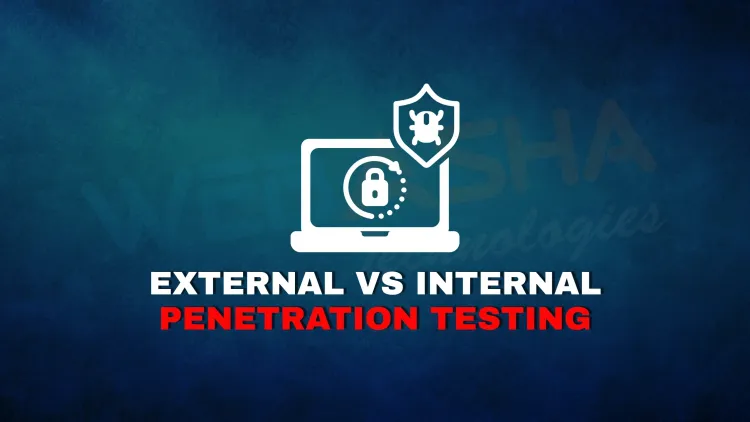What is the difference between external and internal penetration testing?
External vs Internal Penetration Testing refers to two different approaches used to assess security vulnerabilities. External testing simulates an attack from outside the network (like a hacker on the internet), while internal testing mimics an attack from within the organization (like a rogue employee or compromised device). External tests focus on public-facing systems such as websites and firewalls, whereas internal tests assess lateral movement, access control, and privilege escalation within internal networks. Understanding both types is essential for a complete cybersecurity defense strategy.

Table of Contents
- What Is External Penetration Testing?
- What Is Internal Penetration Testing?
- Key Differences Between External and Internal Penetration Testing
- When Should You Perform External vs Internal Testing?
- Can You Do Both External and Internal Pentesting Together?
- Tools Used in External and Internal Pentests
- Conclusion
- Frequently Asked Questions (FAQs)
Penetration testing (or pentesting) is a crucial cybersecurity practice that involves simulating cyberattacks on your systems to find vulnerabilities before real hackers do. But not all pentests are the same. Two of the most widely used approaches are External Penetration Testing and Internal Penetration Testing.
Each of these tests serves a different purpose, focuses on a different threat vector, and mimics different kinds of attackers. In this blog, we’ll break down the differences between external and internal penetration testing, their goals, methodologies, use cases, and how to decide which one your organization needs—or whether you need both.
What Is External Penetration Testing?
External penetration testing simulates an attack from an outsider or someone with no prior access to your internal network. It targets public-facing assets such as:
-
Websites
-
Email servers
-
VPN gateways
-
Firewalls
-
DNS servers
-
Cloud environments
Goals of External Pentesting:
-
Identify vulnerabilities in internet-facing systems
-
Check how easy it is for an attacker to breach your perimeter
-
Test how well your firewalls and security configurations hold up
-
Evaluate password policies, SSL configurations, ports, etc.
Example Scenario:
A hacker scans a company’s IP range and finds a misconfigured web server. With an external pentest, testers try to exploit this and see if they can gain access or steal sensitive data.
What Is Internal Penetration Testing?
Internal penetration testing mimics an attacker who already has access to the organization's internal network. This could be:
-
A disgruntled employee
-
A contractor
-
A hacker who’s already bypassed external defenses
It assumes the attacker is “inside” and tests lateral movement, privilege escalation, and internal data access.
Goals of Internal Pentesting:
-
Identify what damage a rogue user or compromised system can do
-
Test access control, segmentation, and privilege boundaries
-
Assess the organization’s incident detection and response capabilities
-
Simulate insider threats or attacks from a breached device
Example Scenario:
A tester connects to the company Wi-Fi as a guest and tries to access internal HR records or admin shares.
Key Differences Between External and Internal Penetration Testing
| Feature | External Penetration Testing | Internal Penetration Testing |
|---|---|---|
| Attack Origin | From outside the organization’s network | From within the internal network |
| Threat Actor Simulated | External hackers, cybercriminals | Insiders, malicious employees, compromised users |
| Scope | Public-facing servers, firewalls, apps | Internal apps, shares, user privileges, segmentation |
| Network Access | No prior access to the internal systems | Full or limited access to internal systems |
| Objective | Find perimeter weaknesses and entry points | Assess post-breach impacts and lateral movement |
| Common Targets | Web apps, VPNs, SMTP, DNS, APIs | File servers, databases, Active Directory, endpoints |
| Tooling Used | Nmap, Nikto, Burp Suite, Nessus | BloodHound, Mimikatz, Metasploit, CrackMapExec |
| Use Case | Testing perimeter defense against outsiders | Testing internal security and insider threat protection |
| Frequency | Often done before launching a product or after updates | Regularly in secure environments, often after incidents |
| Time Required | Typically 3–7 days depending on scope | Varies based on access level and internal complexity |
When Should You Perform External vs Internal Testing?
Choose External Penetration Testing When:
-
You’ve deployed a new web app or public-facing API
-
You want to assess the security of your internet-facing infrastructure
-
You’ve never done a pentest and want a starting point
-
You want to check how vulnerable you are to attackers on the internet
Choose Internal Penetration Testing When:
-
You want to assess insider threats
-
Your internal security policies or segmentation have changed
-
You’ve already done external testing and want a deeper layer of protection
-
You're preparing for compliance audits like HIPAA, ISO 27001, or PCI DSS
Can You Do Both External and Internal Pentesting Together?
Yes! In fact, doing both is recommended as part of a comprehensive cybersecurity strategy. External testing helps you build stronger perimeters, while internal testing ensures that if someone gets in, the damage they can do is minimal.
Many red team assessments include both elements, simulating an attack from the outside and then moving internally to test lateral movement, data exfiltration, and privilege escalation.
Tools Used in External and Internal Pentests
| Purpose | Tools Used Externally | Tools Used Internally |
|---|---|---|
| Scanning and Recon | Nmap, Shodan, Censys | Angry IP Scanner, Netdiscover |
| Vulnerability Detection | Nessus, OpenVAS | Nexpose, Qualys |
| Exploitation | Metasploit, SQLMap | Metasploit, Mimikatz |
| Web App Testing | Burp Suite, OWASP ZAP | Burp Suite (Internal Web Portals) |
| Privilege Escalation | — | PowerUp, WinPEAS, LinPEAS |
| Lateral Movement | — | BloodHound, CrackMapExec |
Conclusion
External and internal penetration tests are both vital—they look at your organization’s security from different angles. While external pentests simulate hackers trying to break in from the outside, internal pentests show you what damage can happen from within.
To stay secure in today’s evolving cyber threat landscape, businesses should regularly conduct both types of tests, either through internal teams or trusted cybersecurity vendors.
FAQs
What is external penetration testing?
External penetration testing simulates attacks from outsiders, targeting public-facing systems like websites, email servers, or firewalls to find vulnerabilities.
What is internal penetration testing?
Internal penetration testing assumes an attacker already has access to your internal network and tries to exploit privileges, lateral movement, or internal data access.
Why is internal penetration testing important?
It helps detect insider threats, misconfigurations, and weaknesses in internal controls that attackers could exploit after breaching your perimeter.
When should I perform external penetration testing?
When launching a new web app, after system updates, or periodically to assess internet-facing systems for security gaps.
How often should internal pentests be conducted?
Ideally once or twice a year, especially after significant infrastructure or access control changes.
What are some tools used in external pentesting?
Tools like Nmap, Nessus, Burp Suite, and Nikto are commonly used for scanning, vulnerability detection, and exploitation.
What are some tools used in internal pentesting?
Internal tools include Mimikatz, BloodHound, Metasploit, WinPEAS, and CrackMapExec.
Which type of pentest simulates an insider threat?
Internal penetration testing simulates the actions of a malicious employee or a compromised device within the network.
What are the goals of external pentesting?
To test the security of internet-facing infrastructure, identify open ports, misconfigurations, and vulnerabilities.
What are the goals of internal pentesting?
To identify privilege escalation paths, sensitive data exposure, and poor segmentation in the internal network.
Can both internal and external penetration tests be done together?
Yes, combining both gives a full view of security gaps—from perimeter defenses to internal vulnerabilities.
Is external testing enough to secure a company?
No. External testing is essential, but internal threats must also be assessed to ensure complete security.
What’s the biggest risk of ignoring internal pentests?
You may miss threats from compromised insiders or undetected malware already in the system.
How is data exfiltration tested in internal pentests?
By simulating the movement of sensitive data from internal systems to unauthorized destinations.
Do small businesses need internal pentesting?
Yes, especially if they store sensitive data or rely on multiple employees and internal systems.
How long does a typical penetration test take?
Anywhere from a few days to weeks, depending on scope and complexity.
What is lateral movement in internal testing?
It refers to moving through the network from one compromised system to others to gain more access.
Is cloud security tested in external pentests?
Yes, cloud services that are public-facing are part of external penetration testing scope.
Are credentials required for internal testing?
Often yes. The tester may start with a standard user account or compromised machine access.
What is privilege escalation?
It's when an attacker gains higher-level access than they originally had, often using vulnerabilities or misconfigurations.
Which test helps in compliance audits?
Both can help, but internal pentesting is critical for meeting requirements like ISO 27001 or PCI DSS.
Can penetration testing stop ransomware?
Not directly, but it helps identify weaknesses that ransomware could exploit, allowing you to fix them proactively.
Do external pentests cover DDoS attacks?
Usually no. DDoS testing is a separate type of assessment, but availability testing may be included in some scopes.
What is the main limitation of external pentesting?
It doesn’t reveal what an attacker could do if they were already inside the network.
What if we have a strong firewall—do we need internal testing?
Yes. Firewalls don’t protect against insider threats or attacks from compromised endpoints.
Can external pentesting help protect APIs?
Yes, APIs that are exposed to the internet are tested during external assessments.
Who performs penetration testing?
Certified professionals like CEH, OSCP, or CISSP holders, usually from a cybersecurity firm or internal security team.
What industries need both types of pentests?
Finance, healthcare, government, and tech companies with sensitive data or compliance requirements.
How much does a penetration test cost?
It varies, but typically ranges from $5,000 to over $50,000 depending on scope and complexity.
Is red team testing different from internal or external pentests?
Yes. Red teaming is a broader exercise that includes social engineering, physical attacks, and a full-spectrum security test.














![Top 10 Ethical Hackers in the World [2025]](https://www.webasha.com/blog/uploads/images/202408/image_100x75_66c2f983c207b.webp)








